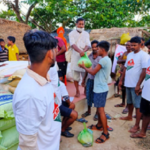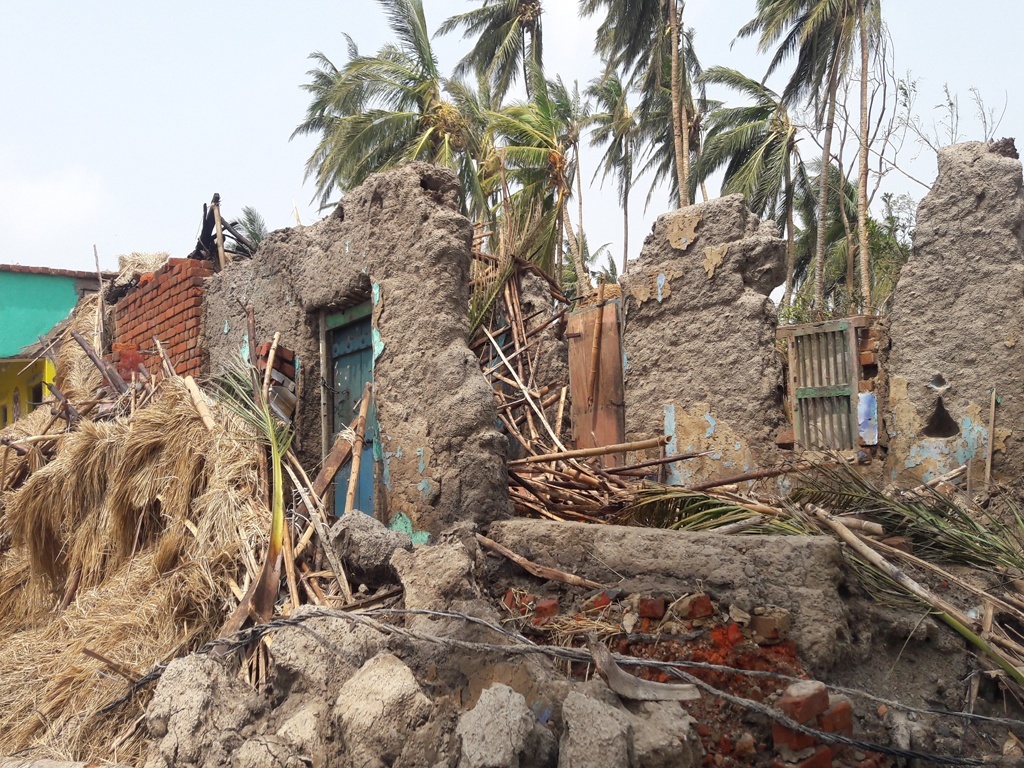Reducing Disaster Vulnerability and Addressing Climate Change Concerns
CYSD’s response to any disaster is two-fold; when there is any kind of disaster. The organization’s disaster rescue team immediately rushes to the victims with relief and with necessary support, and facilitate a quick response to salvage the situation. Secondly, the rescue team facilitates a collaborative civil society response to the emergency by various stakeholders active in the state for wider impact. CYSD also facilitates formation of a Volunteers’ bases to encourage participation of volunteers in relief and rescue operation. Primarily, the thrust remains on Relief, Restoration/ Reconstruction and Rehabilitation to reduce disaster risks and vulnerability through a coordinated effort. Creating awareness and preparedness through Community based planning & capacity building programmes is key to its effort.
CYSD has been continuing its role as strong regional player in disaster response, preparedness and enhance its effort towards innovating climate change adaptation practices and research
Strategic Interventions
Efforts have been made towards strengthening institutional capacities at different levels right from Village Level Disaster Management Committee to the State level; preparing communities in disaster prone areas with life skills, like rescue operations, safety norms, social solidarity features, etc; promoting school safety in disaster prone areas; and facilitating the development and maintaining the disaster resilient infrastructures, like cyclone shelters, etc. More importantly, the organization makes effort to contribute to alliance building of government and non-government agencies active in the areas of emergency preparedness and response; document key learning and best practices; and facilitate monitoring of disaster entitlements with a clear focus on poor, women, children and physically challenged groups.
The organization is endeavoring to foster technical innovation and community adaptation measures at the community level; standardize and upscale effective adaptation measures and mainstream them in long term adaptation planning at the State and national level; document traditional climate resilient practices and to promote them as State development and poverty reduction strategies; and build understanding about climate change mitigation actions, global protocols and instruments like REDD+, voluntary carbon market, etc
Programme Interventions
CYSD has been making concerted efforts to develop a band of youth to respond in disaster situations, to revisit disaster preparedness plans of schools, and to undertake follow up activities when and where required. Youth group/volunteers from coastal districts, NSS volunteers, Members of Youth Red Cross Society are imparted training on Disaster Preparedness and Risk Reduction (DPRR) on periodic basis.
CYSD has initiated key actions in its operational districts with significant tribal populations, to promote climate resilient models in agriculture, adapt System of Rice Intensification (SRI) practice, apply water conservation techniques, practice climate resilient agriculture, and bring about regeneration of forests, use of renewable energy, carbon sequestration initiatives, clean and green energy promotion through local communities
With the intention of ensuring environment friendly livelihoods for the tribal farmers, village level training programmes are for Farmers’ Club members have been organized. The training covers regarding creation and maintenance of community water bodies, solid waste management, organic farming, use of plantation (social forestry and orchard) techniques, etc. resulting which there will be reduction in adverse impacts of climate change. The participants are mainly encouraged to adopt climate friendly livelihoods and to promote water conservation system, like rainwater harvesting, check dams, organic farming, land bonding, plantations, and corner pits in agricultural lands, especially in the context of sustainable agricultural practices and for optimal use of water resources
Forest Protection/Regeneration
The livelihoods of tribal communities depend on forest, agriculture, and wage labour. As the quality of forest, land, and water improves, so does the livelihood of the people living off them. A lot of effort is given for sensitizing the community members on the importance of forests and its link with their life and livelihoods. Various activities are adopted to achieve this outcome, including training/orientation programmes for community members, for eco-club members, for observation of world environment day, for Banamahotsav etc.
As a result of these efforts, the community members have been gradually showing a great deal of ownership towards forest protection and regeneration activities. It is not just the producer group members but rather the whole village that takes part in seed dibbling and plantation activities in the forest. Apart from forest species, attention is paid to plantation of fruit bearing plants such as mango, jackfruit, tamarind, and amla, which will not only provide income, food and medicines to the community members, but also create eco-friendly community.
The forest protection activities are done with collaborative effort between community members, members of Vana Sangrakshyana Samiti, (or the Forest Protection Committee), and the forest department.
Agro-Forestry
Agro-forestry as a long-term productive asset for a household has been promoted in cultivable wastelands, thereby substantially augmenting income of the participating households. The inter-cropping gives immediate monetary returns to the family and also supplementing nutrition to members. The participating household members also earn wage labor through MGNREGS while preparing the field and digging pits.
Mango saplings, bio-fertilizers and pesticides, pitchers, and tree guards are mobilized through mainstream programmes such as Special Central Assistance to Tribal Sub Plan. Further, hill grass plantation is initiated in forest land as well as in common land by involving producer groups. Apart from the plantations, inter-cropping (with black gram, green gram, horse gram, niger, maize, minor millets (ragi), and vegetables) and border cropping have been promoted.

 In September 2020, floods in rivers caused a devastating situation in the State, badly affecting 1.4 Million people in 3256 villages of 896 GPs in 112 Blocks of 20 districts of Odisha. Bari Block of Jajpur district was the worst affected geography in the state. In Bari block, more than 10000 houses got damaged, 75737 hectares of farmland in 13 of the 29 flood-affected GPs got submerged and sand was deposited by the flood water.
In September 2020, floods in rivers caused a devastating situation in the State, badly affecting 1.4 Million people in 3256 villages of 896 GPs in 112 Blocks of 20 districts of Odisha. Bari Block of Jajpur district was the worst affected geography in the state. In Bari block, more than 10000 houses got damaged, 75737 hectares of farmland in 13 of the 29 flood-affected GPs got submerged and sand was deposited by the flood water.
 A severe cyclonic storm “Phailin” with wind speed of more than 220 km per hour struck Odisha on 12th October 2013 resulting in massive devastation and severe floods in many districts. Incessant rain followed the cyclone brought floods in two phases.
A severe cyclonic storm “Phailin” with wind speed of more than 220 km per hour struck Odisha on 12th October 2013 resulting in massive devastation and severe floods in many districts. Incessant rain followed the cyclone brought floods in two phases. A tornado struck at Rajkanika block in Kendrapara district of Orissa on 31 March 2009 at 4.30 PM that entailed large scale devastation in 11 villages belonging to 5 gram panchayats of the block throwing life out of gear. The tornado took a toll of 17 lives and injured over 300 persons that include mostly women and children.
A tornado struck at Rajkanika block in Kendrapara district of Orissa on 31 March 2009 at 4.30 PM that entailed large scale devastation in 11 villages belonging to 5 gram panchayats of the block throwing life out of gear. The tornado took a toll of 17 lives and injured over 300 persons that include mostly women and children. Odisha has always been a victim of disasters. Apart from the natural disasters such as floods and cyclones, persistent droughts also affect the interiors of the state. CYSD’s new stragic plan calls for strategic interventions and initiatives for strengthening disaster response both in the civil society space and across other sectors.
Odisha has always been a victim of disasters. Apart from the natural disasters such as floods and cyclones, persistent droughts also affect the interiors of the state. CYSD’s new stragic plan calls for strategic interventions and initiatives for strengthening disaster response both in the civil society space and across other sectors. Odisha witnessed a severe spate of floods in 2006 affecting 12 districts with a loss of 22 lives. The worst hit district was kendrapada with a total 4, 98,854 people affected in 612 villages. Sustain ed water logging posed a serious threat on an epidemic with no access to basic human health services and safe drinking water, and livestock were stranded with little or no access to water, fodder, and veterinary medicines.
Odisha witnessed a severe spate of floods in 2006 affecting 12 districts with a loss of 22 lives. The worst hit district was kendrapada with a total 4, 98,854 people affected in 612 villages. Sustain ed water logging posed a serious threat on an epidemic with no access to basic human health services and safe drinking water, and livestock were stranded with little or no access to water, fodder, and veterinary medicines. The state witnessed severe floods caused by unusually heavy rains in 2001 and 2003 affecting many districts of Odisha. The affected villages were cut up from main cities, the flooding damage to property, destruction of crops, and loss of livestock, deterioration of health conditions owing to waterborne diseases.
The state witnessed severe floods caused by unusually heavy rains in 2001 and 2003 affecting many districts of Odisha. The affected villages were cut up from main cities, the flooding damage to property, destruction of crops, and loss of livestock, deterioration of health conditions owing to waterborne diseases. Odisha was battered by a Super Cyclonic Storm on 29 October, 1999 that made landfall near Paradip (43976). The estimated maximum wind speed reached 260-270 kmph in the core area which produced a huge storm surge that led to sea-level elevation of more than 20 feet and took away valuable lives of nearly 10,000 people.
Odisha was battered by a Super Cyclonic Storm on 29 October, 1999 that made landfall near Paradip (43976). The estimated maximum wind speed reached 260-270 kmph in the core area which produced a huge storm surge that led to sea-level elevation of more than 20 feet and took away valuable lives of nearly 10,000 people.